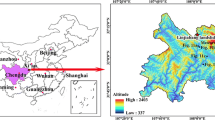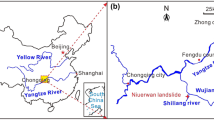Abstract
With the rapid urbanization, an increasing number of landslides have been induced by human activities. In this study, a typical human-induced landslide known as the Maobazi landslide, which was triggered by foundation pit excavation in Sichuan Province, China, was analyzed. An emergency investigation was carried out to detect the basic deformation characteristics, followed by implementations of multiple monitoring schemes and emergency control measures to monitor and control reactivated deposits. The reactivated deposits depicted rapid deformations with a maximum deformation exceeding 140 mm from July to September before the emergency control measures were completed. The reactivated deposits gradually settled and were finally controlled in 2019. The results showed that the 2019 Maobazi landslide was a large; reactivated landslide with a scale reached to 520 Mm3, which could result in catastrophic consequences if it slipped down to nearby residential areas.












Similar content being viewed by others
References
Aguilar AG, Ward PM, Smith SCB (2003) Globalization, regional development, and mega-city expansion in Latin America: analyzing Mexico City’s peri-urban hinterland. Cities 20(1):3–21
Alupoae D (2013) Landslides–a result of urban expansion in the metropolitan area of Iasi City. The Bulletin of the Polytechnic Institute of Jassy, Construction. Architecture Section 59(2):69–78
Bozzano F, Cipriani I, Mazzanti P, Prestininzi A (2011) Displacement patterns of a landslide affected by human activities: insights from ground-based InSAR monitoring. Nat Hazards 59(3):1377–1396
Cui Y, Cheng D, Choi CE, ** W, Lei Y, Kargel JS (2019) The cost of rapid and haphazard urbanization: lessons learned from the Freetown landslide disaster. Landslides 16(6):1167–1176
Dai ZH (2002) Study on distribution laws of landslide-thrust and resistance of sliding mass acting on antislide piles. Chin J Rock Mech Eng 21(4):517–521
Diaz VJ (1992) Landslides in the squatter settlements of Caracas; towards a better understanding of causative factors. Environ Urban 4(2):80–89
Fan X, Tang J, Tian S, Jiang Y (2020) Rainfall-induced rapid and long-runout catastrophic landslide on July 23, 2019 in Shuicheng, Guizhou, China. Landslides 1–11
Froude MJ, Petley DN (2018) Global fatal landslide occurrence from 2004 to 2016. Nat Hazard 18(8):2161–2181
Griffiths JS, Hutchinson JN, Brunsden D, Petley DJ, Fookes PG (2004) The reactivation of a landslide during the construction of the Ok Ma tailings dam, Papua New Guinea. Q J Eng GeolHydrogeol 37(3):173–186
Hare GREG, Rivas S (2005) The landslide hazard and human vulnerability in La Paz City. Bolivia Geographical Journal 171(3):239–258
Huang QX, Xu XT, Kulatilake PHSW, Lin F (2020) Formation mechanism of a rainfall triggered complex landslide in southwest China. J Mt Sci 17:1128–1142
Huang R, Fan X (2013) The landslide story. Nat Geosci 6(5):325–326
Korup O, Clague JJ, Hermanns RL, Hewitt K, Strom AL, Weidinger JT (2007) Giant landslides, topography, and erosion. Earth Planet Sci Lett 261:578–589
Kotiukov PV, Lange IY (2019) Engineering geological analysis of the landslide causes during the construction of industrial building. International Journal of Civil Engineering and Technology 10(3):1471–1478
Li P, Liu C, Zhang Y, Zhang J, Yang J, Feng T (2019) Construction practice of landslide during tunneling in hilly topography. Eng Fail Anal 104:1234–1241
Li W, Zhao B, Xu Q, Yang F, Fu H, Dai C, Wu X (2020) Deformation characteristics and failure mechanism of a reactivated landslide in Leidashi, Sichuan, China, on August 6, 2019: an emergency investigation report. Landslides 1–9
Ma S, Xu C, Xu X, He X, Qian H, Jiao Q, Li K (2020) Characteristics and causes of the landslide on July 23, 2019 in Shuicheng, Guizhou Province, China. Landslides 1–12
Ouyang C, Zhou K, Xu Q, Yin J, Peng D, Wang D, Li W (2017) Dynamic analysis and numerical modeling of the 2015 catastrophic landslide of the construction waste landfill at Guangming, Shenzhen. China Landslides 14(2):705–718
Piciullo L, Gariano SL, Melillo M, Brunetti MT, Peruccacci S, Guzzetti F, Calvello M (2017) Definition and performance of a threshold-based regional early warning model for rainfall-induced landslides. Landslides 14(3):995–1008
Ran Q, Hong Y, Li W, Gao J (2018) A modelling study of rainfall-induced shallow landslide mechanisms under different rainfall characteristics. J Hydrol 563:790–801
Ranagalage M, Murayama Y, Dissanayake DMSLB, Simwanda M (2019) The impacts of landscape changes on annual mean land surface temperature in the tropical mountain city of Sri Lanka: a case study of Nuwara Eliya (1996–2017). Sustainability 11(19):5517
Saldivar-Sali A, Einstein HH (2007) A landslide risk rating system for Baguio. Philippines Engineering Geology 91(2–4):85–99
Segoni S, Piciullo L, Gariano SL (2018) A review of the recent literature on rainfall thresholds for landslide occurrence. Landslides 15(8):1483–1501
SCDK - Sichuan Institute of Geological Engineering Investigation Group Co., Ltd (2019) The emergency investigation report of 2019 Maobazi landslide at Tai** Town, Wanyuan city, Sichuan Province, China [Landslide report] (In Chinese)
Su LJ, Hu KH, Zhang WF, Wang J, Lei Y, Zhang CL, Zheng QH (2017) Characteristics and triggering mechanism of **nmo landslide on 24 June 2017 in Sichuan. China Journal of Mountain Science 14(9):1689–1700
Sun HY, Pan P, Lü Q, Wei ZL, **e W, Zhan W (2019) A case study of a rainfall-induced landslide involving weak interlayer and its treatment using the siphon drainage method. Bull Eng Geol Env 78(6):4063–4074
Wang Z, Lu C (2018) Urban land expansion and its driving factors of mountain cities in China during 1990–2015. J Geog Sci 28(8):1152–1166
Wu S, Shi L, Wang R, Tan C, Hu D, Mei Y, Xu R (2001) Zonation of the landslide hazards in the forereservoir region of the Three Gorges Project on the Yangtze River. Eng Geol 59(1–2):51–58
Yao Y (2018) Study on the influence of human activities on loess landslide. In 2017 3rd International Forum on Energy, Environment Science and Materials (IFEESM 2017). Atlantis Press
Zhan LT, Zhang Z, Chen YM, Chen R, Zhang S, Liu J, Li AG (2018) The 2015 Shenzhen catastrophic landslide in a construction waste dump: reconstitution of dump structure and failure mechanisms via geotechnical investigations. Eng Geol 238:15–26
Zhao B, Li W, Wang Y, Lu J, Li X (2019) Landslides triggered by the Ms 6.9 Nyingchi earthquake, China (18 November 2017): analysis of the spatial distribution and occurrence factors. Landslides 16(4):765-776
Zhao B, Zhang H, Liao HJ, Li W, Su L, He W, Dhital MR (2021) Emergency response to the reactivated Aniangzhai landslide resulting from a rainstorm-triggered debris flow, Sichuan Province, China. Landslides 1–16
Zhao X, Wang YS, Wang SY (2020) Nature and timing of a prehistoric giant landslide on the eastern margin of the Tibetan Plateau. J Mt Sci 17(6):1438–1451
Acknowledgements
This study was supported by the National Natural Science Foundation of China (Grant No. 42007273), the “Belt & Road" international cooperation team for the “Light of West” program of CAS (Su Lijun), Special Assistant Researcher Foundation of Chinese Academy of Sciences (Zhao Bo), the China Postdoctoral Science Foundation (2020M673292, 2021T140650) and the IMHE Youth S&T Foundation (SDS-QN-2106). The authors express their gratitude for this financial assistance.
Author information
Authors and Affiliations
Corresponding authors
Ethics declarations
Conflict of interest
The authors declare no competing interests.
Rights and permissions
About this article
Cite this article
Zhao, B., Yuan, L., Geng, X. et al. Deformation characteristics of a large landslide reactivated by human activity in Wanyuan city, Sichuan Province, China. Landslides 19, 1131–1141 (2022). https://doi.org/10.1007/s10346-022-01853-3
Received:
Accepted:
Published:
Issue Date:
DOI: https://doi.org/10.1007/s10346-022-01853-3




